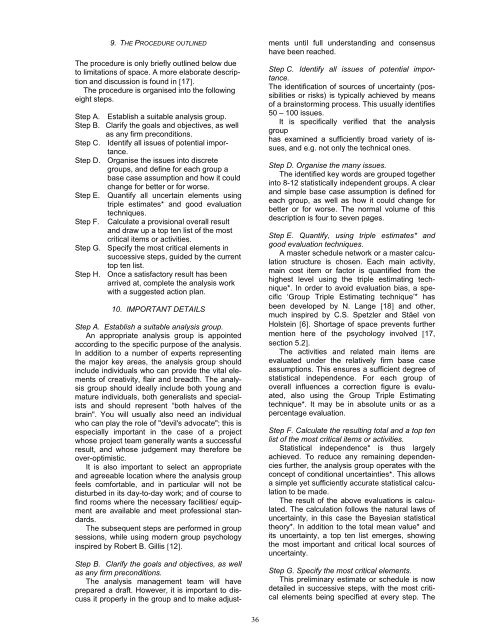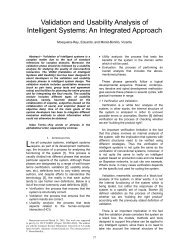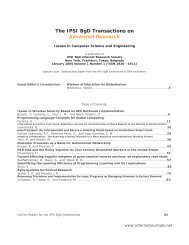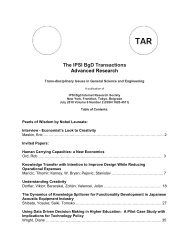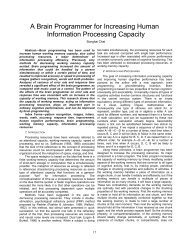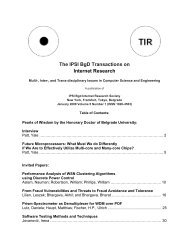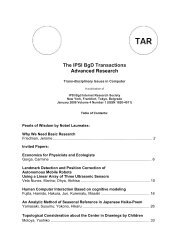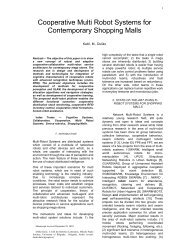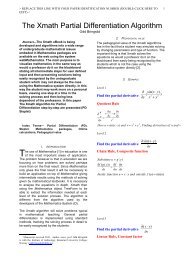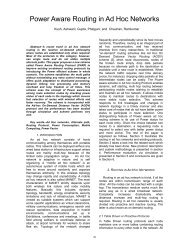The IPSI BgD Transactions on Internet Research - Welcome
The IPSI BgD Transactions on Internet Research - Welcome
The IPSI BgD Transactions on Internet Research - Welcome
You also want an ePaper? Increase the reach of your titles
YUMPU automatically turns print PDFs into web optimized ePapers that Google loves.
9. THE PROCEDURE OUTLINED<br />
<str<strong>on</strong>g>The</str<strong>on</strong>g> procedure is <strong>on</strong>ly briefly outlined below due<br />
to limitati<strong>on</strong>s of space. A more elaborate descripti<strong>on</strong><br />
and discussi<strong>on</strong> is found in [17].<br />
<str<strong>on</strong>g>The</str<strong>on</strong>g> procedure is organised into the following<br />
eight steps.<br />
Step A. Establish a suitable analysis group.<br />
Step B. Clarify the goals and objectives, as well<br />
as any firm prec<strong>on</strong>diti<strong>on</strong>s.<br />
Step C. Identify all issues of potential importance.<br />
Step D. Organise the issues into discrete<br />
groups, and define for each group a<br />
base case assumpti<strong>on</strong> and how it could<br />
change for better or for worse.<br />
Step E. Quantify all uncertain elements using<br />
triple estimates* and good evaluati<strong>on</strong><br />
techniques.<br />
Step F.<br />
Calculate a provisi<strong>on</strong>al overall result<br />
and draw up a top ten list of the most<br />
critical items or activities.<br />
Step G. Specify the most critical elements in<br />
successive steps, guided by the current<br />
top ten list.<br />
Step H. Once a satisfactory result has been<br />
arrived at, complete the analysis work<br />
with a suggested acti<strong>on</strong> plan.<br />
10. IMPORTANT DETAILS<br />
Step A. Establish a suitable analysis group.<br />
An appropriate analysis group is appointed<br />
according to the specific purpose of the analysis.<br />
In additi<strong>on</strong> to a number of experts representing<br />
the major key areas, the analysis group should<br />
include individuals who can provide the vital elements<br />
of creativity, flair and breadth. <str<strong>on</strong>g>The</str<strong>on</strong>g> analysis<br />
group should ideally include both young and<br />
mature individuals, both generalists and specialists<br />
and should represent “both halves of the<br />
brain". You will usually also need an individual<br />
who can play the role of "devil's advocate"; this is<br />
especially important in the case of a project<br />
whose project team generally wants a successful<br />
result, and whose judgement may therefore be<br />
over-optimistic.<br />
It is also important to select an appropriate<br />
and agreeable locati<strong>on</strong> where the analysis group<br />
feels comfortable, and in particular will not be<br />
disturbed in its day-to-day work; and of course to<br />
find rooms where the necessary facilities/ equipment<br />
are available and meet professi<strong>on</strong>al standards.<br />
<str<strong>on</strong>g>The</str<strong>on</strong>g> subsequent steps are performed in group<br />
sessi<strong>on</strong>s, while using modern group psychology<br />
inspired by Robert B. Gillis [12].<br />
Step B. Clarify the goals and objectives, as well<br />
as any firm prec<strong>on</strong>diti<strong>on</strong>s.<br />
<str<strong>on</strong>g>The</str<strong>on</strong>g> analysis management team will have<br />
prepared a draft. However, it is important to discuss<br />
it properly in the group and to make adjustments<br />
until full understanding and c<strong>on</strong>sensus<br />
have been reached.<br />
Step C. Identify all issues of potential importance.<br />
<str<strong>on</strong>g>The</str<strong>on</strong>g> identificati<strong>on</strong> of sources of uncertainty (possibilities<br />
or risks) is typically achieved by means<br />
of a brainstorming process. This usually identifies<br />
50 – 100 issues.<br />
It is specifically verified that the analysis<br />
group<br />
has examined a sufficiently broad variety of issues,<br />
and e.g. not <strong>on</strong>ly the technical <strong>on</strong>es.<br />
Step D. Organise the many issues.<br />
<str<strong>on</strong>g>The</str<strong>on</strong>g> identified key words are grouped together<br />
into 8-12 statistically independent groups. A clear<br />
and simple base case assumpti<strong>on</strong> is defined for<br />
each group, as well as how it could change for<br />
better or for worse. <str<strong>on</strong>g>The</str<strong>on</strong>g> normal volume of this<br />
descripti<strong>on</strong> is four to seven pages.<br />
Step E. Quantify, using triple estimates* and<br />
good evaluati<strong>on</strong> techniques.<br />
A master schedule network or a master calculati<strong>on</strong><br />
structure is chosen. Each main activity,<br />
main cost item or factor is quantified from the<br />
highest level using the triple estimating technique*.<br />
In order to avoid evaluati<strong>on</strong> bias, a specific<br />
‘Group Triple Estimating technique’* has<br />
been developed by N. Lange [18] and other,<br />
much inspired by C.S. Spetzler and Stäel v<strong>on</strong><br />
Holstein [6]. Shortage of space prevents further<br />
menti<strong>on</strong> here of the psychology involved [17,<br />
secti<strong>on</strong> 5.2].<br />
<str<strong>on</strong>g>The</str<strong>on</strong>g> activities and related main items are<br />
evaluated under the relatively firm base case<br />
assumpti<strong>on</strong>s. This ensures a sufficient degree of<br />
statistical independence. For each group of<br />
overall influences a correcti<strong>on</strong> figure is evaluated,<br />
also using the Group Triple Estimating<br />
technique*. It may be in absolute units or as a<br />
percentage evaluati<strong>on</strong>.<br />
Step F. Calculate the resulting total and a top ten<br />
list of the most critical items or activities.<br />
Statistical independence* is thus largely<br />
achieved. To reduce any remaining dependencies<br />
further, the analysis group operates with the<br />
c<strong>on</strong>cept of c<strong>on</strong>diti<strong>on</strong>al uncertainties*. This allows<br />
a simple yet sufficiently accurate statistical calculati<strong>on</strong><br />
to be made.<br />
<str<strong>on</strong>g>The</str<strong>on</strong>g> result of the above evaluati<strong>on</strong>s is calculated.<br />
<str<strong>on</strong>g>The</str<strong>on</strong>g> calculati<strong>on</strong> follows the natural laws of<br />
uncertainty, in this case the Bayesian statistical<br />
theory*. In additi<strong>on</strong> to the total mean value* and<br />
its uncertainty, a top ten list emerges, showing<br />
the most important and critical local sources of<br />
uncertainty.<br />
Step G. Specify the most critical elements.<br />
This preliminary estimate or schedule is now<br />
detailed in successive steps, with the most critical<br />
elements being specified at every step. <str<strong>on</strong>g>The</str<strong>on</strong>g><br />
36


